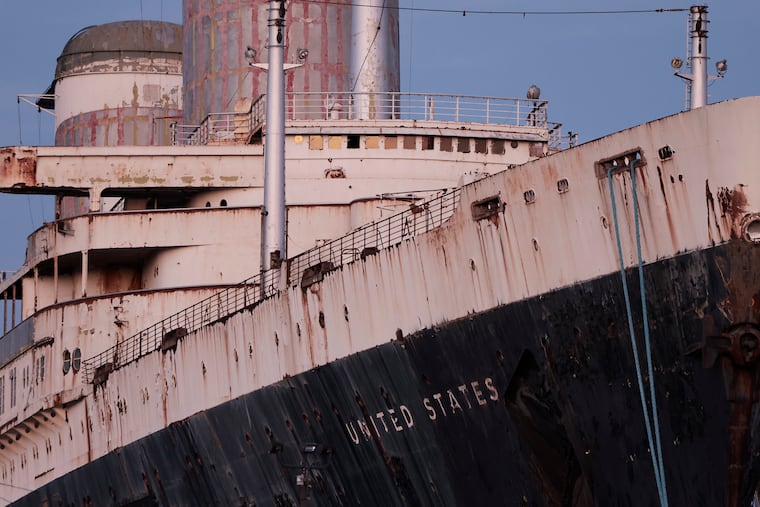SS United States must have a plan by Sept. 12 to leave South Philly, judge says
“You’re not entitled to be at the pier forever,” U.S. District Judge Anita B. Brody said to the ship's stewards.

The stewards of the SS United States, a 1,000-foot vessel colloquially known as South Philadelphia’s Ikea boat, have to forge and finalize a deal to move the ship by Sept. 12 or risk losing custody of the ocean steam liner to its current landlord Penn Warehousing.
It’s not the reprieve the SS United States Conservancy, which has long sought to give the ship new life, angled for in federal court Monday. The group wanted U.S. District Judge Anita B. Brody to reconsider a June decision that gave them until mid-September to move the ship.
But Brody denied the motion, saying she was concerned that giving the Conservancy any extension would lead to attorneys “crying” in court, pleading for more time as the revised deadline approached.
“You’re not entitled to be at the pier forever,” Brody told Conservancy attorney Scott E. Wardell.
Brody did give the Conservancy a partial victory. The group only needs to have a plan to move the ship finalized by the September deadline. Failure to do so opens the door for the Conservancy to lose possession of the SS United States to its landlord.
Monday’s hearing was the latest development in the ship’s yearslong rent dispute with its Pier 82 landlord. Penn Warehousing wanted to double the daily dockage fee in 2021 for the SS United States to $1,700 but the Conservancy refused to acknowledge the new rate, arguing the lease that prevented such a rent spike. The parties ended up in court early this year.
The saga appeared to reach a climax in June. Brody absolved the Conservancy from paying the back rent Penn Warehousing claimed the ship owed on account of the rent increase, but made clear the vessel had to move. A month later, the Conservancy asked the judge to let the ship stay in place until December.
Court filings from Conservancy attorneys cited a laundry list of logistical to-dos, such as getting U.S. Coast Guard approval for the move, stability assessments, and an active hurricane season expected to last until November.
The Conservancy’s biggest hurdle has been finding a partner it deems suitable for their preservation ambitions. Ideally, the Conservancy wanted to find a white knight who would help it redevelop the ship into a mixed-use destination that would include a museum commemorating the former “Queen of the Seas.”
Yet even finding a temporary berth that would give the Conservancy more time to find that perfect partner proved to be difficult. Court filings revealed the Philadelphia Navy Yard, the Virginia Port Authority, the Maryland Port Authority, the North Carolina State Ports Authority, the South Carolina Ports Authority, and the Georgia Ports Authority had been dead ends.
Two counties in Florida have expressed interest in acquiring the boat but with one major catch unappealing to the Conservancy: Escambia and Okaloosa Counties would want to sink the SS United States and turn it into an artificial reef to bring more tourism.
Publicly, the Conservancy has said sinking the ship is “clearly not” its first choice. But in court Monday, Wardell pinned the delay in sealing a deal on the counties, who he said had reservations about the tight timeline.
» READ MORE: Some officials in Florida want to sink the SS United States. The ship’s stewards say not so fast.
Penn Warehousing attorney Craig Mills accused the Conservancy of dragging its feet on moving the “toxic time bomb.” Brody wanted to know what the holdup was if there were interested parties.
“Why do you need the extra time if you have a solution?” she said, adding she was sympathetic to the efforts to preserve the ship.
Throughout the hearing, Brody acknowledged what the Conservancy has been reluctant to say: Redevelopment plans are no more feasible than they were when the ship docked at Pier 82 almost 30 years ago and the ship couldn’t continue to stay in its current berth.
“It’s not realistic, we all have to live in realism,” she said.
Mills said Penn Warehousing was satisfied with the decision and his client looks forward to putting “Pier 82 North back into productive commercial use.” The plan would be for Penn Warehousing to negotiate a lease extension with the new owners of the SS United States once a deal is struck to transfer ownership.